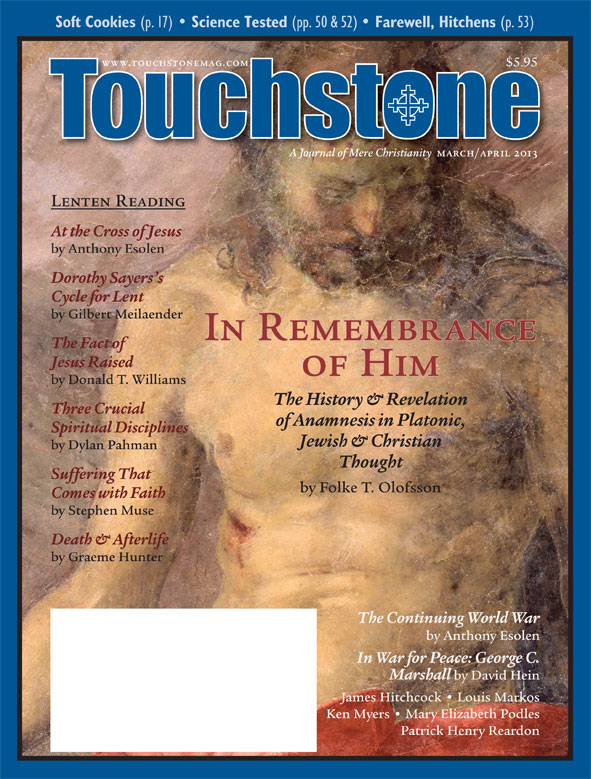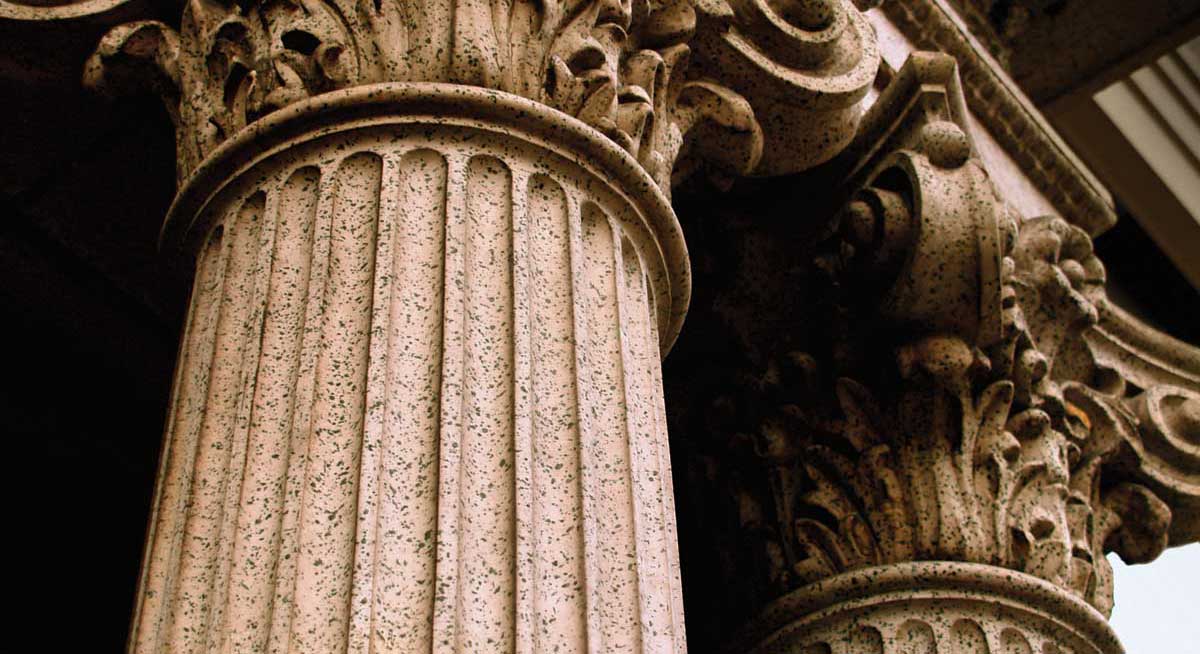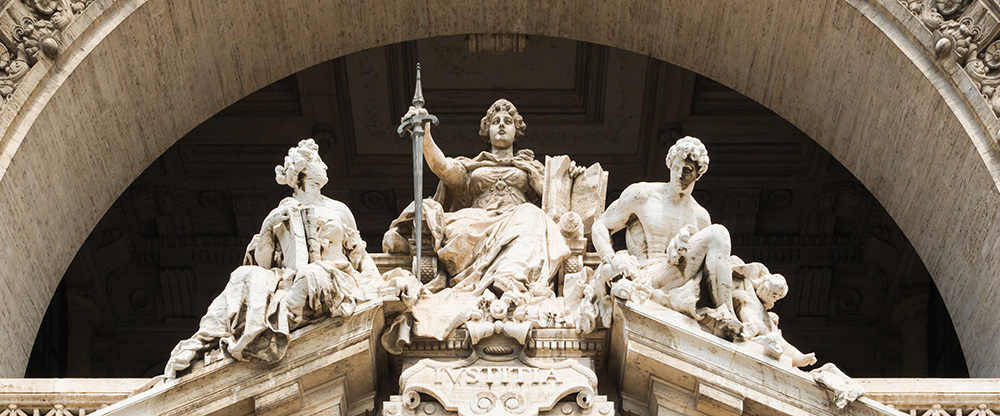ILLUMINATIONS
At the Cross of Jesus
At the end of Sir Gawain and the Green Knight, the good Gawain approaches the Green Chapel, where he is certain he must die. It's New Year's Day, the snow lies deep, and a grindstone hums nearby. As far as Sir Gawain knows, it's sharpening the ax that will shear off his head. "I'll be with you right away," calls the demonic Green Knight from behind the chapel. That chapel is a place of foreboding. There is no cross.
I've been to a chapel without a cross. It was converted from an old factory. The windowless inner "worship room" boasted electronic equipment for music and videos, but no cross. I felt, there, a little like Gawain. There's something wrong, in the sense of being crooked, bent, about a chapel without a cross. It cannot lead to good.
The Question of Christianity
Quite different is the wisdom of a remarkable five-part hymn by one Edward Monro: "The Story of the Cross"(1864). The first part is The Question:
See Him in raiment rent,
With His blood dyed:
Women walk sorrowing
By His side.Heavy that Cross to Him,
Weary the weight:
One who will help Him stands
At the gate.Multitudes hurrying
Pass on the road:
Simon is sharing with
Him the load.Who is this travelling
With the curst tree—
This weary prisoner—
Who is He?
The terse meter provides, at the end of each stanza, a moment of extraordinary pathos. For the last line is "missing" its first syllable. It begins on a strong beat, set apart from the meter of the rest of the stanza. The women walk in sorrow, where? By His side. Who is this weary prisoner? Who is He? That is the question of Christianity, right there.

Son of God
The second part is The Answer:
Follow to Calvary,
Tread where He trod;
This is the Lord of life—
Son of God.Is there no loveliness—
You who pass by—
In that lone Figure which
Marks the sky?You who would love Him, stand,
Gaze at His face;
Tarry awhile in your
Worldly race.As the swift moments fly
Through the blest week,
Jesus, in penitence,
Let us seek.
This is poetry worthy of Emily Dickinson; spare, laconic, immensely suggestive. The pronoun this, from The Question, is supplied in The Answer. If you want to know who this weary prisoner is, you must follow in his steps, up the bitter mountain. Then you will learn what seems impossible to the world. This weary prisoner, this man, battered and despised, is the Lord of life—Son of God, as the centurion professed.How powerful is the break in the sentence, and the omission of the definite article! It's as if the reply comes with a clutch in the throat: this is what it means to be Son of God.
The next stanza delivers two powerful allusions to Scripture. Isaiah says of the Suffering Servant, "He hath no form or comeliness; and when we shall see him, there is no beauty that we should desire him" (53:2). Spiritual beauty, Francois Mauriac wrote, attracts one man irresistibly, while others don't notice it, or are repelled by it: as to some people the countenance of the aged Mother Teresa was only withered and ugly. The poet begs us to find the beauty of Jesus, not simply to pass him by. He alludes to the Lamentations of Jeremiah, after the destruction of Jerusalem; the text foretells the suffering of the Messiah: "It is nothing to you, all ye who pass by? Behold, and see if there be any sorrow like unto my sorrow" (1:12). Why do the people pass by? The worldly race preoccupies them.
The world races to dissolution, and people race to attain things that perish. In this blest week at least, we should leave that race, and tarry awhile, to gaze upon the countenance of Jesus, seeking him in penitence, and finding in him our salvation.
Motifs of the Crucifixion
In the third part of the poem, we address the Lord personally:
On the Cross lifted up,
Thy face I scan,
Scarred by that agony—
Son of Man.Thorns form Thy diadem,
Rough wood Thy throne,
To Thee Thy outstretched arms
Draw Thine own.Nails hold Thy hands and feet,
While on Thy breast
Sinketh Thy bleeding head
Sore opprest.Loud is Thy bitter cry,
Rending the night,
As to Thy darkened eyes
Fails the light.Shadows of midnight fall,
Though it is day;
Friends and disciples stand
Far away.Loud scoffs the dying thief,
Mocking Thy woe;
Can this my Savior be
Brought so low?Yes, see the title clear,
Written above,
'Jesus of Nazareth'—
Name of love!What, O my Savior dear,
What didst Thou see,
That made Thee suffer and
Die for me?
The poet combines motifs from the Crucifixion with those that look forward to it and those that recall it. "When ye have lifted up the Son of man," said Jesus to the Pharisees, "then shall ye know that I am he" (John 8:28). That elevation is to the throne of the Cross, with the crown of thorns as his diadem, fulfilling the prophecy of Daniel: "Behold, one like the Son of man came with the clouds of heaven, and came to the Ancient of days, and they brought him near before him. And there was given him dominion, and glory, and a kingdom" (7:13–14). "And I," said Jesus, "if I be lifted up from the earth"—he is speaking about both the Crucifixion and his ascension to the Father—"will draw all men unto me" (John 12:32). Those arms are flung wide to embrace all who would come to him.
Munro tells the story of the Crucifixion with great skill: the nails, the cry of desolation, the darkness, the jeering thief, the sign nailed to the top of the cross. Friends and disciples stand—where? Alas, far away. Can this man lifted high on the cross be the Savior—brought so low? Yes, there is the sign: 'Jesus of Nazareth.' What does that mean? Love. What, from your exalted vantage, Jesus, did you see that moved you to grant me the greatest gift of your love, to die for me?
The Way for Thee
In the fourth part the Lord responds:
Child of my grief and pain!
From realms above,
I came to lead thee to
Life and love.For thee my blood I shed,
For thee I died;
Safe in thy faithfulness
Now abide.I saw thee wandering,
Weak and at strife;
I am the Way for thee,
Truth and Life.Follow my path of pain,
Tread where I trod:
This is the way of peace
Up to God.
Jesus came for the speaker, for each of us, because he saw us wandering, weak and at strife. Again and again, he uses the personal pronoun thee; he does not save a generalized mankind; he saves us. Hence the emphatic reversal: For thee my blood I shed, / For thee I died. Hence the insertion of the pronoun into the famous verse: I am the way for thee: I am the way you must go.
What is that way? It is the road to Calvary. It is the way of love, even in suffering, even unto death. Only at the side of the pierced Lord do we find peace.
Star of My Soul
So in the final part of the poem, the speaker replies to Jesus with eager love:
O I will follow Thee,
Star of my soul!
Through the great dark I press
To the goal.Yea, let me know Thy grief,
Carry Thy cross,
Share in Thy sacrifice,
Gain Thy loss.Daily I'll prove my love
Through joy and woe;
Where Thy hands point the way,
There I go.Lead me on year by year,
Safe to the end,
Jesus, my Lord, my Life,
King and Friend.
Not one word is idle. The auxiliary will is emphatic: I will follow, I am resolved. The verb follow, appearing for the third time, echoes the words of Jesus, and is the touchstone of the poem. Jesus is the star of my soul, the polestar, fixed in place, the star to sail by, in the darkness of this life. If we die with him, shall we not also rise? •
Anthony Esolen is Distinguished Professor of Humanities at Thales College and the author of over 30 books, including Real Music: A Guide to the Timeless Hymns of the Church (Tan, with a CD), Out of the Ashes: Rebuilding American Culture (Regnery), and The Hundredfold: Songs for the Lord (Ignatius). He has also translated Dante’s Divine Comedy (Random House) and, with his wife Debra, publishes the web magazine Word and Song (anthonyesolen.substack.com). He is a senior editor of Touchstone.
subscription options
Order
Print/Online Subscription

Get six issues (one year) of Touchstone PLUS full online access including pdf downloads for only $39.95. That's only $3.34 per month!
Order
Online Only
Subscription

Get a one-year full-access subscription to the Touchstone online archives for only $19.95. That's only $1.66 per month!
bulk subscriptions
Order Touchstone subscriptions in bulk and save $10 per sub! Each subscription includes 6 issues of Touchstone plus full online access to touchstonemag.com—including archives, videos, and pdf downloads of recent issues for only $29.95 each! Great for churches or study groups.
Transactions will be processed on a secure server.
more from the online archives
calling all readers
Please Donate
"There are magazines worth reading but few worth saving . . . Touchstone is just such a magazine."
—Alice von Hildebrand
"Here we do not concede one square millimeter of territory to falsehood, folly, contemporary sentimentality, or fashion. We speak the truth, and let God be our judge. . . . Touchstone is the one committedly Christian conservative journal."
—Anthony Esolen, Touchstone senior editor









